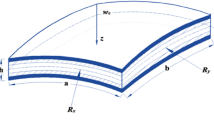Abstract
Based on the general six-degrees-of-freedom plate theory towards the accurate stress analysis and nonlinear theory of shallow shells, considering the damage effect of the interlaminar interface and using the variation principle, the three-dimensional non-linear equilibrium differential equations of the laminated shallow shells with interfacial damage are derived. Then, considering a simply supported laminated shallow shell with damage and under normal load, an analytical solution is presented by using finite difference method to obtain the interlaminar stresses. Numerical results show, the stiffness of the shell is weakened, greater absolute values of displacements as well as smaller interlaminar stresses are obtained by interfacial damage. When the interfacial damage is further increased, delamination occurs obviously under normal pulling load and pure shear slip occurs under normal pressure load. The portion of the load undertaken by the two sides of the interface is more different. Different mechanical behaviors are shown in both sides of the interface, and the discontinuation of stresses and displacements takes place in the interface.
Similar content being viewed by others
References
You, X.M., Zhao, H.F. and Wei, Y.G., Determination of interfacial mechanical parameters Foranal/Epoxy/Al2O3 system by using peel test simulations. Acta Mechanica Solida Sinica, 2008, 20(3): 198–206.
Zakaria, K., Sirwah, M.A. and Assaf, A., Magnetohydrodynamics instability of interfacial waves between two immiscible incompressible cylindrical fluids. Acta Mechanica Sinica, 2008, 24: 497–514.
Needleman, A., A continuum model for void nucleation by inclusion debonding. Journal of Applied Mechanics, 1987, 54(3): 525–531.
Needleman, A., An analysis of decohersion along an imperfect interface. Interational Journal of Fracture, 1990, 42(1): 21–40.
Toledano, A. and Murakami, H., Shear-deformable two-layer plate theory with interlayer slip. ASCE Journal of Engineering Mechanics Division, 1988, 144(4): 604–623.
Soldatos, K.P. and Watson, P., A general four-degrees-of-freedom theory suitable for the accurate stress analysis of homogeneous and laminated composite beams. International Journal of Solids and Structures, 1997, 34(22): 2857–2885.
Soldatos, K.P. and Watson, P., A method for improving the stress analysis performance of one- and two-dimensional theories for laminated composites. Acta Mechanica, 1997, 123(3): 163–186.
Soldatos, K.P. and Watson, P., Accurate stress analysis of laminated plates combining a two-dimensional theory with the exact three-dimensional solution for simply supported edges. Mathematics and Mechanics of Solids, 1997, 2(4): 459–489.
Shu, X.P., A generalized model of laminated composite plates with interfacial damage. Composite Structure, 2006, 74: 237–246.
Kim, G.W. and Lee, K.Y., Influence of weak interfaces on buckling of orthotropic rectangular laminates. Composite Structure, 2007, 81: 427–431.
Kim, G.W. and Lee, K.Y., Optimization of orthotropic rectangular laminates with weak interfaces under buckling. Composites: Part A: Applied Science and Manufacturing, 2007, 38: 265–271.
Barbero, E.J. and Reddy, J.N., Modeling of delamination in composite laminates using a layer-wise plate theory. International Journal of Solids and Structures, 1991, 28(3): 373–388.
Point, N. and Sacco, E., Delamination of deams: an application of the DCB specimen. International Journal of Fracture, 1996, 79: 225–247.
Fu, Y.M., Li, S. and Jiang, Y.J., A constitutive model for composite laminated plates with the damage effect of the intra-layers and inter-laminar interface is presented. Acta Mechanica Solida Sinica, 2008, 2(2): 127–140.
Shu, X.P. and Kostas, P.S., An accurate de-lamination model for weakly bonded laminates subjected to different set of edge boundary conditions. International Journal of Mechanical Sciences, 2001, 43: 935–959.
Kostas, P.S. and Shu, X.P., Modeling of perfectly and weakly bonded laminated plates and shallow shells. Composites science and technology, 2001, 61: 247–260.
Kostas, P.S. and Shu, X.P., On the stress analysis of cross-ply laminated plates and shallow shell panels. Composite structures, 1999, 26: 333–344.
Huang, N.N., Influence of shear correction factors in the higher-order shear deformation of laminated shell theory. International Journal of Solids Structure, 1994, 31: 1263–1277.
Author information
Authors and Affiliations
Corresponding author
Additional information
Project supported by the National Natural Science Foundation of China (No. 11072076).
Rights and permissions
About this article
Cite this article
Fu, Y., Li, S. & Mao, Y. The Analysis of Interlaminar Stresses for Composite Laminated Shallow Shells with Interfacial Damage. Acta Mech. Solida Sin. 24, 539–555 (2011). https://doi.org/10.1016/S0894-9166(11)60054-2
Received:
Revised:
Published:
Issue Date:
DOI: https://doi.org/10.1016/S0894-9166(11)60054-2




